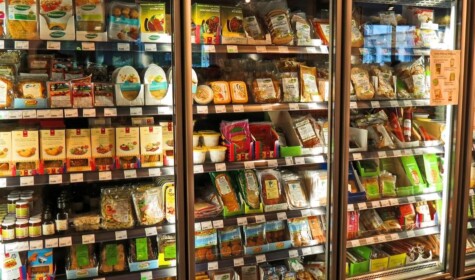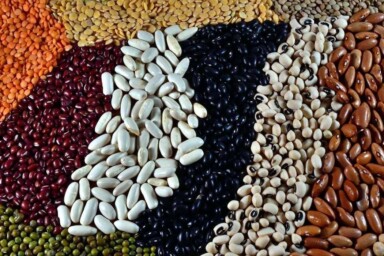The discussion over what makes a sustainable, healthy diet has become an all out war in the press, online and at our dinner tables, with everyone desperate to find the silver bullet that reverses the climate crisis that farming so often finds itself at the centre of.
As this argument grumbles on, and many make dietary pledges to make changes for the good of the environment, we thought we should take a hard look at one of our blind spots: processed food. What constitutes processed food and what’s the difference between healthy and unhealthy processed foods – and how can you tell what’s good for you and what’s not? (Clue: it’s on the packaging, and the less packaging there is, the healthier it’s likely to be!)
The widely accepted definition of processed and ultra-processed foods comes from the United Nations Food and Agriculture Organisation’s NOVA classification system which breaks foods down into four levels of processing:
Group 1 – unprocessed and minimally processed foods
These foods are pretty much as they are grown, raised or fished and if anything is done to them, it’s generally to make it consumable. The only processing of this food is the ‘removing of undesirable parts’ such as stems or leaves. Food might also be fermented, ground or preserved in certain ways to make it last longer. In moderation, all foods in this group are part of a healthy diet.
Group 2 – processed culinary ingredients
Including oils, fats, butter and lard, these foods are directly derived from group 1 foods, but might go through a process of pressing, refining, grinding, milling or drying. They don’t offer much nutritional value on their own but are generally used to make meals tastier.
Group 3 – processed foods
Perhaps surprisingly, this group includes canned veg, which shows that not all processed food is unhealthy. Group 3 foods will tend to include 2-3 ingredients and are generally still recognisable as group 1 or 2 foods. Tinned pulses and fruit and freshly baked ‘real’ bread are included, as well as cheeses and cured meats like bacon or salami. Processed foods can become unhealthy when additional salt or sugar is added, and, as you don’t tend to make many of these foods at home, it’s hard to control the amount that’s added.
Group 4 – ultra-processed food
A phrase like ‘typically created by a series of industrial techniques’ is not something you’ll find on the packaging of ultra-processed food, but this is the FAO’s definition. You likely won’t find the ingredients used in ultra-processed food in your kitchen, they are made for convenience (as in ‘oven-ready’), have a long shelf life and have gone through industrial processes designed to enhance flavour with more salt and sugar than you imagined – all this adds up to a dangerously addictive dinner. Most ready-to-consume products fall into this category.
How to easily identify ultra-processed food
A good test to decide if a product is ultra-processed or not, is to look at the ingredients list and look for any products or additives which you wouldn’t have in your kitchen. These tend to appear in the middle of the ingredients list, and might also include flavour enhancers, colouring, emulsifiers, emulsifying salts, artificial sweeteners, thickeners and foaming, anti-foaming, bulking, carbonating, gelling and glazing agents. Ultra-processed food can also have trans fats which come from partially hydrogenated oil and are particularly unhealthy – they have, in fact, been banned in the US, and in the UK, there is a voluntary ban which most of the major supermarkets have supported.
Another good way to tell if a food is ultra-processed is the branding and marketing. If it’s got beautifully thought-out artwork, lots of claims on how ‘good’ it is (for the planet or for you) or even its own hashtag, chances are it’s ultra-processed. (Carrots have been doing just fine without their own brand managers for centuries.) So, don’t be sold by the images and claims as they are unlikely to stand up to scrutiny. Keep in mind that words like ‘natural’ or ‘healthy’ can mean anything in this context!
Futher, it’s easy for minimally processed foods to become ultra-processed. When flavourings and sugar are added to porridge, it zips from minimally processed straight through to ultra-processed. Plain yoghurt is a minimally processed product, and does wonders for gut bacteria, but the bad can out-weigh the good when preservatives or sweeteners are added.
Why should I avoid ultra-processed food?
A meta-analysis of the impact of ultra-processed food done by the FAO across a range countries, observed that the more processed foods in a person’s diet, the more likely they are to have lower levels of fibre, potassium, magnesium and vitamin C, and to have more added sugar and saturated fat. More frightening, a British Medical Journal study found that those on ultra-processed diets were 62% more likely to be obese or have cardiovascular and metabolic diseases, cancers, depression, gastrointestinal disorders, frailty and even premature mortality.
With around 56% of the calories in UK diets coming from ultra-processed foods, and as a country which needs to cut its meat consumption, it is easy to assume that going ‘plant-based’ puts you on the road to healthy and environmentally friendly eating. But that is far from the reality – much ‘plant-based’ food is ultra-processed. So, steer clear of the supermarket’s central aisles and go for the fresh fruit and veg. To suggest an edit to the old adage, ‘good things come in less packaging’.







